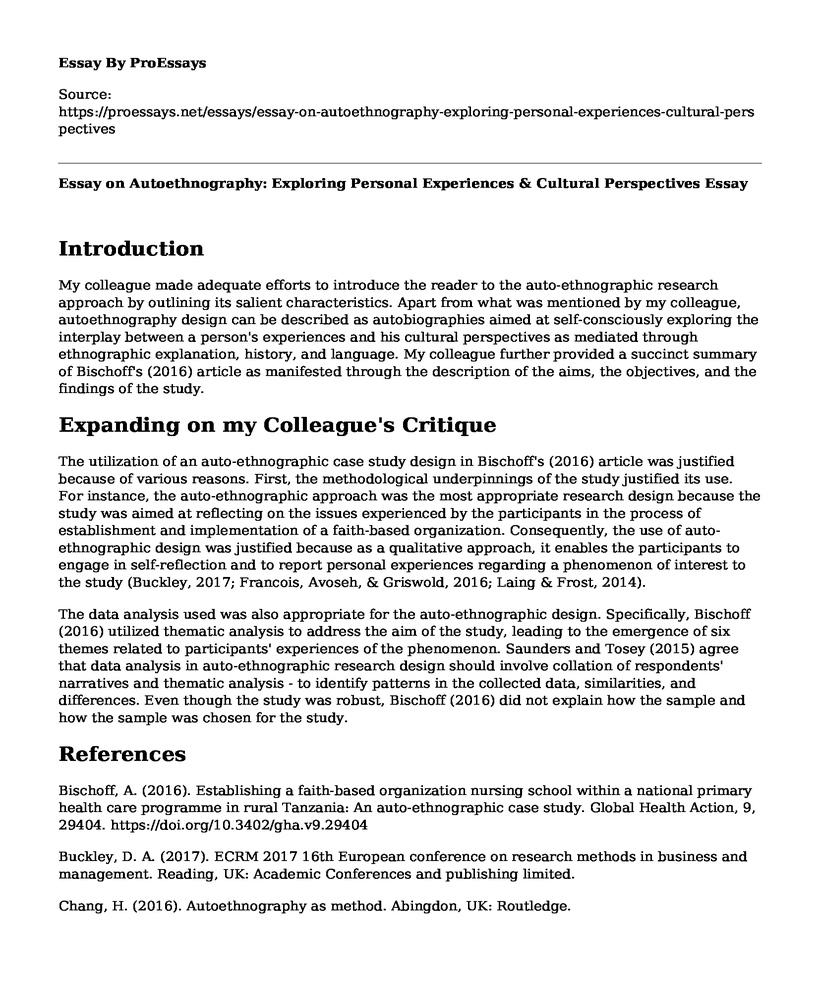Introduction
My colleague made adequate efforts to introduce the reader to the auto-ethnographic research approach by outlining its salient characteristics. Apart from what was mentioned by my colleague, autoethnography design can be described as autobiographies aimed at self-consciously exploring the interplay between a person's experiences and his cultural perspectives as mediated through ethnographic explanation, history, and language. My colleague further provided a succinct summary of Bischoff's (2016) article as manifested through the description of the aims, the objectives, and the findings of the study.
Expanding on my Colleague's Critique
The utilization of an auto-ethnographic case study design in Bischoff's (2016) article was justified because of various reasons. First, the methodological underpinnings of the study justified its use. For instance, the auto-ethnographic approach was the most appropriate research design because the study was aimed at reflecting on the issues experienced by the participants in the process of establishment and implementation of a faith-based organization. Consequently, the use of auto-ethnographic design was justified because as a qualitative approach, it enables the participants to engage in self-reflection and to report personal experiences regarding a phenomenon of interest to the study (Buckley, 2017; Francois, Avoseh, & Griswold, 2016; Laing & Frost, 2014).
The data analysis used was also appropriate for the auto-ethnographic design. Specifically, Bischoff (2016) utilized thematic analysis to address the aim of the study, leading to the emergence of six themes related to participants' experiences of the phenomenon. Saunders and Tosey (2015) agree that data analysis in auto-ethnographic research design should involve collation of respondents' narratives and thematic analysis - to identify patterns in the collected data, similarities, and differences. Even though the study was robust, Bischoff (2016) did not explain how the sample and how the sample was chosen for the study.
References
Bischoff, A. (2016). Establishing a faith-based organization nursing school within a national primary health care programme in rural Tanzania: An auto-ethnographic case study. Global Health Action, 9, 29404. https://doi.org/10.3402/gha.v9.29404
Buckley, D. A. (2017). ECRM 2017 16th European conference on research methods in business and management. Reading, UK: Academic Conferences and publishing limited.
Chang, H. (2016). Autoethnography as method. Abingdon, UK: Routledge.
Francois, E. J., Avoseh, M. B. M., & Griswold, W. (2016). Perspectives in transnational higher education. New York, NY: Springer.
Laing, J., & Frost, W. (2014). Rituals and traditional events in the modern world. Abingdon, UK: Routledge.
Saunders, M. N. K., & Tosey, P. (2015). Handbook of research methods on human resource development. Edward Elgar Publishing.
Cite this page
Essay on Autoethnography: Exploring Personal Experiences & Cultural Perspectives. (2023, Feb 09). Retrieved from https://proessays.net/essays/essay-on-autoethnography-exploring-personal-experiences-cultural-perspectives
If you are the original author of this essay and no longer wish to have it published on the ProEssays website, please click below to request its removal:
- Summertime and School Isn't Easy Essay
- Development Theories to Life Experiences Essay
- Impacts of Social Media on College and the Car Industry Paper Example
- The Influence of the FIFA 2018 on the Quality of Service Offered in Russia Paper Example
- Case Study: Rheumatoid Arthritis
- Essay Example on Assessing Teaching & Learning Effectiveness: Educational Research
- Essay Example on Critical Thinking: Activated Ignorance & Intellectual Autonomy







